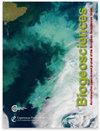天然土壤中磷组分的全球格局和驱动因素
IF 3.9
2区 地球科学
Q1 ECOLOGY
引用次数: 0
摘要
摘要土壤中的大多数磷(P)不能被直接生物吸收,因为它被锁在初级或次级矿物颗粒中,被吸附在矿物表面,或被固定在有机物质中。破译土壤中不同形态磷的组成对理解磷的生物有效性及其潜在动态至关重要。然而,广泛使用的不同土壤磷形态的全球估计是基于包含少量测量的数据集,其中许多地区或土壤类型未被代表。这对依赖这些估计值来量化土壤磷对控制全球粮食生产和陆地碳平衡的生物活动的限制的评估构成了主要的不确定性来源。为了解决这个问题,我们整合了一个包含6种主要土壤P“形态”的数据库,其中包含来自全球分布的(半)自然土壤和11个相关环境变量的1857个条目。这六种不同形式的磷(不稳定的无机磷(Pi),不稳定的有机磷(Po),中等不稳定的Pi,中等不稳定的Po,原生矿物磷和封闭磷)使用顺序P分选方法进行测量。由于它们不代表土壤中特定的离散磷化合物的精确形式,而是类似于操作池,我们现在将它们称为磷池。为了量化11个土壤形成变量在预测土壤磷库浓度中的相对重要性,然后在全球尺度上进行进一步预测,我们对每个磷库训练了随机森林回归模型,并捕获了R2大于60%的观测变化。我们发现土壤全磷浓度是所有土壤磷库浓度的最重要预测因子,除了初级矿质磷浓度,初级矿质磷浓度主要受土壤pH控制,其次受土壤全磷浓度控制。当以相对值(全磷的比例)表示时,该模型表明,土壤pH通常是所有土壤磷库比例的最重要预测因子,其次是土壤有机碳、全磷浓度、土壤深度和生物群系的显著影响。这些结果表明,虽然磷库的浓度值在逻辑上强烈依赖于土壤全磷浓度,但不同池的相对值受到其他土壤性质和环境背景的调节。利用训练好的随机森林模型,我们以0.5°×0.5°的分辨率预测了自然系统中土壤磷库的分布。我们绘制的土壤中不同磷库的全球地图以及这些库的潜在驱动因素可以为评估自然磷有效性对生态系统生产力、减缓气候变化和地球系统功能的作用提供信息。本文章由计算机程序翻译,如有差异,请以英文原文为准。
Global patterns and drivers of phosphorus fractions in natural soils
Abstract. Most phosphorus (P) in soils is unavailable for direct biological uptake, as it is locked within primary or secondary mineral particles, adsorbed to mineral surfaces, or immobilized inside of organic material. Deciphering the composition of different P forms in soil is critical for understanding P bioavailability and its underlying dynamics. However, widely used global estimates of different soil P forms are based on a dataset containing few measurements in which many regions or soil types are unrepresented. This poses a major source of uncertainty in assessments that rely on these estimates to quantify soil P constraints on biological activity controlling global food production and terrestrial carbon balance. To address this issue, we consolidated a database of six major soil P “forms” containing 1857 entries from globally distributed (semi-)natural soils and 11 related environmental variables. These six different forms of P (labile inorganic P (Pi), labile organic P (Po), moderately labile Pi, moderately labile Po, primary mineral P, and occluded P) were measured using a sequential P fractionation method. As they do not represent precise forms of specific discrete P compounds in the soil but rather resemble operational pools, we will now refer to them as P pools. In order to quantify the relative importance of 11 soil-forming variables in predicting soil P pool concentrations and then make further predictions at the global scale, we trained random forest regression models for each of the P pools and captured observed variation with R2 higher than 60 %. We identified total soil P concentration as the most important predictor of all soil P pool concentrations, except for primary mineral P concentration, which is primarily controlled by soil pH and only secondarily by total soil P concentration. When expressed in relative values (proportion of total P), the model showed that soil pH is generally the most important predictor for proportions of all soil P pools, alongside the prominent influences of soil organic carbon, total P concentration, soil depth, and biome. These results suggest that, while concentration values of P pools logically strongly depend on soil total P concentration, the relative values of the different pools are modulated by other soil properties and the environmental context. Using the trained random forest models, we predicted soil P pools' distributions in natural systems at a resolution of 0.5∘×0.5∘. Our global maps of different P pools in soils as well as the pools' underlying drivers can inform assessments of the role of natural P availability for ecosystem productivity, climate change mitigation, and the functioning of the Earth system.
求助全文
通过发布文献求助,成功后即可免费获取论文全文。
去求助
来源期刊

Biogeosciences
环境科学-地球科学综合
CiteScore
8.60
自引率
8.20%
发文量
258
审稿时长
4.2 months
期刊介绍:
Biogeosciences (BG) is an international scientific journal dedicated to the publication and discussion of research articles, short communications and review papers on all aspects of the interactions between the biological, chemical and physical processes in terrestrial or extraterrestrial life with the geosphere, hydrosphere and atmosphere. The objective of the journal is to cut across the boundaries of established sciences and achieve an interdisciplinary view of these interactions. Experimental, conceptual and modelling approaches are welcome.
 求助内容:
求助内容: 应助结果提醒方式:
应助结果提醒方式:


